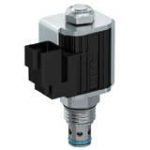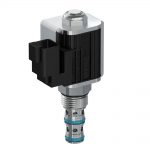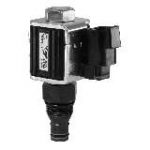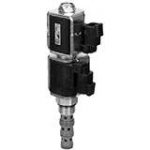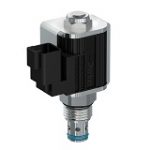HYDRAULIC SOLENOID VALVES
HYDRAULIC SOLENOID VALVES
Hydraulic Solenoid Valves
HYDRAULIC SOLENOID VALVES INCLUDE
Parker’s 2-way poppet solenoid valves check flow in one direction with very low leakage and free flow opposite; normally-open or normally-closed configurations available. Capable of pressures up to 350 bar (5000 psi) and flows up to 260 lpm (70 gpm).
Parker’s 2-way poppet style solenoid valves feature a proven design that ensures very low leakage when flow is blocked in one direction and minimized pressure drop in the free flow position. These valves can operate with hydraulic system flows as high as 260 lpm and pressures up to 350 bar with normally-open or normally closed configurations available. Parker’s 2-way poppet solenoid valves are ideal for unloading and load holding applications that require low poppet style leakage within mobile, industrial, or manufacturing markets.
Markets:
• Aerial
• Construction
• Material Handling
• Miscellaneous Industrial
• Miscellaneous Manufacturing
• Miscellaneous Mobile
Features & Benefits:
• Replaceable one-piece coils with low amp draw
• Fast response available
• Manual override options
• Low leakage spherical poppet
• All external parts zinc plated
Applications:
• Unloading circuits
• Load holding applications
• Lift circuits
Additional Technical Insight:
Parker’s 2 way poppet valves are pilot operated, low leakage solenoid actuated valves. Similar to a check valve, these valves will block flow in one direction will very low leakage (5 drops per minute, or less). When actuated, these valves allow flow to pass through the valve. These valves are typically selected due to their low leakage characteristics and their ability to meet higher flow requirements. Poppet valves are often used on single operation actuators or in unloading functions. They are available in normally closed and normally open types with fast response versions available.
Parker’s two way, two position poppet valves consist of a main poppet, a pilot piston, a spring, and a solenoid coil.
The normally closed poppet version of these valves will act as a check valve when the valve is de-energized. This blocks flow in both directions while allowing free flow in the reverse direction. When the coil is energized, the poppet is piloted open (lifts) and allows free flow in the previously checked direction, typically from the side of the cartridge out the nose.
The normally open poppet version of these valves, when the coil is de-energized, will allow free flow from the side port of the valve (port 2) out the nose of the valve (port 1). Energizing the coil shifts the poppet to block flow in both directions.
Operation: The normally closed poppet valve is held on its seat by a spring, blocking the pilot flow. This will allow pressure at the inlet port (port 2) to hold the poppet on its seat preventing flow through the valve (port 2 to port 1).
If the nose of the cartridge (port 1) is pressurized enough to overcome the spring force, and pushing the poppet off of its seat, flow will be allowed through port 1 to port 2. When the coil is energized, the pilot poppet is lifted off of its seat, venting the pressure inside the poppet to port 1. This creates a pressure imbalance across the main poppet, therefore lifting the poppet and allowing flow from the side to the nose (2 to 1). Because these valves are pilot operated, a minimal amount of pressure differential is necessary (25-50 psi), along with flow between ports 2 and 1 must be present to overcome the spring and lift the poppet.
The normally open valve pilot is held off its seat by spring force. Pilot flow is vented to port 1, creating a pressure imbalance that moves the main poppet. This differential lifts the poppet allowing flow from the side to nose (2 to 1). Since poppet valves are pilot operated, a minimum amount of pressure differential (25-50 psi) between ports 2 overcomes the spring force to drive the valve pilot and main poppet into their seats, thus blocking flow from port 2 to 1. If the nose of the cartridge (port 1) is pressurized, the pressure will overcome the spring force and solenoid force, pushing the poppet off of its seat, allowing restricted flow through the cartridge (1 to 2).
Parker offers five different direct acting 3-way, 2-position spool-type solenoid valves to cover a wide range of flows up to 57 lpm (15 gpm) and pressures as high as 350 bar (5000 psi). Coils are available with multiple voltages and connection types.
Parker’s direct acting 3-way, 2-position spool-type solenoid valves feature a proven design that ensures reliable and predictable performance with low pressure drop and minimal hysteresis. These valves can operate with hydraulic system flows as high as 57 lpm (15 gpm) and pressures up to 350 bar (5000 psi) with normally-open, normally closed, or selector configurations available. Parker’s 3-way, 2-position spool-type solenoid valves are ideal for switching or unloading applications that don’t necessarily require low poppet style leakage, but instead easy solenoid driven directional controls. These valves can be used on a wide range of machinery within the mobile, industrial, or manufacturing markets.
Markets:
• Aerial
• Agriculture
• Construction
• Material Handling
• Miscellaneous Industrial
• Miscellaneous Manufacturing
• Miscellaneous Mobile
Features/Benefits:
• Replaceable one-piece coils with low amp draw
• High flow capacity
• Manual override options
• Standard bodies and cavities
• No dynamic seals
• Low hysteresis
• All external parts zinc plated
Applications:
• Switching applications
• Unloading applications
• Diverter applications
Additional Technical Insight:
Direct acting spool valves are fast to respond to coil voltage and will allow flow passage between 2 ports while blocking the remaining port. Some leakage will be present due to spool clearances.
Parker’s 2-way bi-directional poppet solenoid valves block flow both directions with very low leakage and are available in normally-open or normally closed configurations. Capable of pressures up to 350 bar (5000 psi) and flows up to 285 lpm (75 gpm).
Parker’s 2-way bi-directional poppet solenoid valves feature a proven design that ensures very low leakage when in the double-blocking position and minimized pressure drop in the free flow position. These valves can operate with hydraulic system flows as high as 285 lpm and pressures up to 350 bar with normally-open or normally closed configurations available. Some of Parker’s 2-way bi-directional poppet solenoid valves contain built-in thermal reliefs set at 36 bar, but all are ideal for unloading and load holding applications that require low poppet style leakage within mobile, industrial, or manufacturing markets.
Markets:
• Miscellaneous Industrial
• Miscellaneous Manufacturing
• Miscellaneous Mobile
Features & Benefits:
• Fast response
• One piece cartridge housing
• Built in thermal relief available
• All external parts zinc plated
Applications:
• Double-blocking applications
• Unloading circuits
• Load holding applications
• Lift circuits
Additional Technical Insight:
Parker’s 2 way poppet valves are pilot operated, low leakage solenoid actuated valves. Similar to a check valve, these valves will block flow in one direction will very low leakage (5 drops per minute, or less). When actuated, these valves allow flow to pass through the valve. These valves are typically selected due to their low leakage characteristics and their ability to meet higher flow requirements. Poppet valves are often used on single operation actuators or in unloading functions. They are available in normally closed and normally open types with fast response versions available.
Parker’s two way, two position poppet valves consist of a main poppet, a pilot piston, a spring, and a solenoid coil.
The normally closed poppet version of these valves will act as a check valve when the valve is de-energized. This blocks flow in both directions while allowing free flow in the reverse direction. When the coil is energized, the poppet is piloted open (lifts) and allows free flow in the previously checked direction, typically from the side of the cartridge out the nose.
The normally open poppet version of these valves, when the coil is de-energized, will allow free flow from the side port of the valve (port 2) out the nose of the valve (port 1). Energizing the coil shifts the poppet to block flow in both directions.
Operation: The normally closed poppet valve is held on its seat by a spring, blocking the pilot flow. This will allow pressure at the inlet port (port 2) to hold the poppet on its seat preventing flow through the valve (port 2 to port 1).
If the nose of the cartridge (port 1) is pressurized enough to overcome the spring force, and pushing the poppet off of its seat, flow will be allowed through port 1 to port 2. When the coil is energized, the pilot poppet is lifted off of its seat, venting the pressure inside the poppet to port 1. This creates a pressure imbalance across the main poppet, therefore lifting the poppet and allowing flow from the side to the nose (2 to 1). Because these valves are pilot operated, a minimal amount of pressure differential is necessary (25-50 psi), along with flow between ports 2 and 1 must be present to overcome the spring and lift the poppet.
The normally open valve pilot is held off its seat by spring force. Pilot flow is vented to port 1, creating a pressure imbalance that moves the main poppet. This differential lifts the poppet allowing flow from the side to nose (2 to 1). Since poppet valves are pilot operated, a minimum amount of pressure differential (25-50 psi) between ports 2 overcomes the spring force to drive the valve pilot and main poppet into their seats, thus blocking flow from port 2 to 1. If the nose of the cartridge (port 1) is pressurized, the pressure will overcome the spring force and solenoid force, pushing the poppet off of its seat, allowing restricted flow through the cartridge (1 to 2).
Parker has a large selection of direct acting 4-way, 3-position spool-type solenoid valves to cover a wide range of flow requirements up to 57 lpm (15 gpm) and pressures as high as 350 bar (5000 psi); closed, open, float, and tandem centers available.
Parker’s direct acting 4-way, 3-position spool-type solenoid valves feature a robust design that ensures reliable and repeatable performance with minimized pressure drop. These valves can operate with hydraulic system flows up to 57 lpm (15 gpm) and pressures as high as 350 bar (5000 psi) with open, closed, float, and tandem center configurations available. Parker’s 4-way, 3-position spool-type solenoid valves also have manual override options and are perfect for double acting cylinders, pilot circuits, and bi-directional motor applications while utilizing an easy to configure and use double-solenoid stack. These valves can be used on a wide range of machinery within the mobile, industrial, or manufacturing markets.
Markets:
• Aerial
• Agriculture
• Construction
• Material Handling
• Miscellaneous Industrial
• Miscellaneous Manufacturing
• Miscellaneous Mobile
Features/Benefits:
• Replaceable one-piece coils with low amp draw
• High flow capacity
• High pressure capability
• Manual override options
• Low hysteresis
• All external parts zinc plated
Applications:
• Reversing flow
• Actuator applications
• Bi-directional motors
• Pilot circuits
Additional Technical Insight:
Direct acting spool valves are fast to respond to coil voltage and can quickly re-direct or block flow to actuator ports. Some leakage will be present due to spool clearances.
Parker’s direct acting 4-way, 2-position spool-type solenoids offer a simple electronic solution for actuation or reversing applications; available with flows up to 113 lpm (30 gpm) and pressures as high as 350 bar (5000 psi).
Parker’s direct acting 4-way, 2-position spool-type solenoid valves feature a tough design that ensures reliable and predictable performance with low pressure drop and minimal hysteresis. These valves can operate with hydraulic system flows as high as 113 lpm (30 gpm) and pressures up to 350 bar (5000 psi) with normally passing, crossing, or closed configurations available. Parker’s 4-way, 2-position spool-type solenoid valves are ideal for reversing or actuation applications; utilizing easily wired and programmed solenoid driven directional controls. These valves can be used on a wide range of machinery within the mobile, industrial, or manufacturing markets.
Markets:
• Aerial
• Agriculture
• Construction
• Material Handling
• Miscellaneous Industrial
• Miscellaneous Manufacturing
• Miscellaneous Mobile
Features/Benefits:
• Replaceable one-piece coils with low amp draw
• High flow capacity
• Manual override options
• Standard bodies and cavities
• No dynamic seals
• Low hysteresis
• All external parts zinc plated
Applications:
• Reversing flow
• Actuator applications
• Single direction on/off applications
Additional Technical Insight:
Direct acting spool valves are fast to respond to coil voltage and can quickly re-direct or block flow to actuator ports. Some leakage will be present due to spool clearances.
Parker’s selection of direct acting 2-way, 2-position spool-type solenoid valves cover a wide range of flows up to 75 lpm (20 gpm) and pressures as high as 350 bar (5000 psi), with both normally-closed and normally-open options available.
Parker’s direct acting 2-way, 2-position spool-type solenoid valves feature a proven design that ensures reliable and predictable performance with low pressure drop and minimized hysteresis. These valves can operate with hydraulic system flows as high as 75 lpm (20 gpm) and pressures up to 350 bar (5000 psi) with normally-open or normally closed configurations available. Parker’s 2-way, 2-position spool-type solenoid valves are ideal for on/off applications that don’t necessarily require low poppet style leakage, but instead easy solenoid driven directional controls. These valves can be used on a wide range of machinery within the mobile, industrial, or manufacturing markets.
Markets:
• Aerial
• Agriculture
• Construction
• Material Handling
• Miscellaneous Industrial
• Miscellaneous Manufacturing
• Miscellaneous Mobile
Features/Benefits:
• Replaceable one-piece coils with low amp draw
• High flow capacity
• Manual override options
• Standard bodies and cavities
• No dynamic seals
• Low hysteresis
• All external parts zinc plated
Applications:
• Actuation applications
• Unloading applications
Additional Technical Insight:
Direct acting spool valves are fast to respond to coil voltage and will block flow in both directions. Some leakage will be present due to spool clearances so please consider Parker’s 2-way Poppet Valves if leakage less than 5 drops per minute is required. Even though flow is bi-direction, due to flow forces, the preferred flow path is from the side of the cartridge (port 2) to the nose (port 1).

